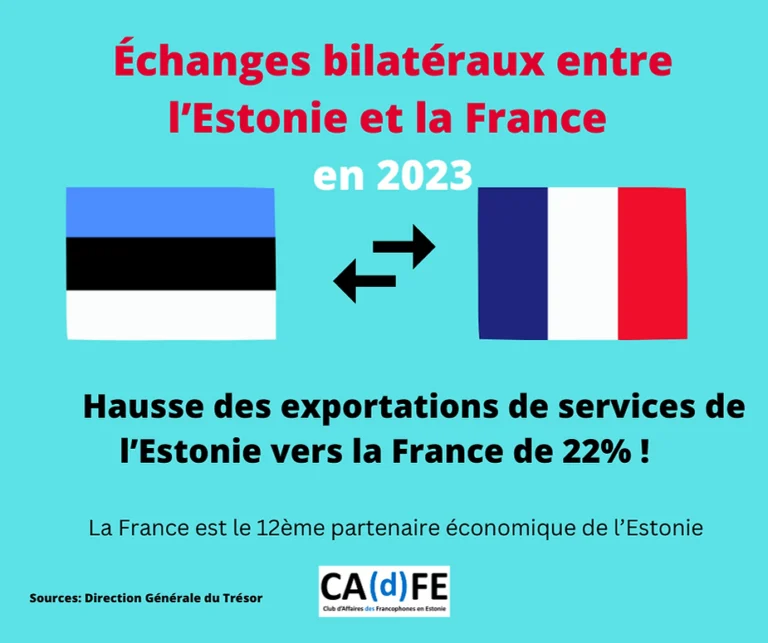
Bilateral trade between Estonia and France in 2023

Although Estonia managed to generate a trade surplus in services, the final trade balance was close to equilibrium, with France conceding a deficit of 17 million euros.
Against a difficult backdrop of falling commodity prices and falling trade with Russia, France moved up one place to become Estonia’s 12th economic partner.
Nevertheless, in comparison with Estonia’s neighbors, Germany and the Anglo-Saxon world, France remains a second-rate partner.
Conversely, Estonia is the Baltic country with which France trades the least, so the partnership remains limited.
-
Trade in goods between France and Estonia is growing, but remains limited
As in 2022, France thus achieves a trade surplus, estimated this year at 49 million euros (+29%).
By 2022, France will be Estonia’s 13th customer and 12th supplier.
Including services, France moves up one place to become Estonia’s 12th economic partner.
Trade with France accounts for 1.9% of Estonia’s foreign trade (+0.2 points), i.e. about as much as the Near and Middle East (including Turkey) or Russia in goods trade.
The top five products sold by value from Estonia are telecommunications equipment, plywood, sawn timber, firewood and prefabricated buildings.
Partly as a result of falling raw material prices, trade concentrated on high value-added products: trade in electrical and electronic equipment rose by 15%, in transport equipment by 19%, while trade in wood products fell by 21% and in chemicals by 48%.
Variations in content are less marked than those of Estonian exports: trade in metals has fallen (-32%), that in transport equipment has risen by 13%, and the rest of the variations are unremarkable.
The top five products sold by France in value terms are cars, rolled steel plates, wine, tractors and medicines.
Spirits, beauty products and perfumes also feature in the top ten.
Of Estonia’s 88 million euros in wine imports, France holds the leading market share at 24%, followed by Italy at 22%.
France also has the third-largest market share (13%) of Estonian spirits imports (96 million euros, representing a growing market of 9% by 2023).
France also leads Estonia in perfume sales (6 million euros, or 16% of the market).
-
Franco-Estonian trade in services has doubled since 2019.
The year 2023 thus marks the transition from a balanced trade balance (+2 million euros for Estonia) to a French deficit (67 million euros).
The latter exceeds the Estonian deficit on trade in goods, making the bilateral relationship a small deficit for France: -17 million euros.
In the medium term, trade in services between Estonia and France is growing strongly: it has doubled since 2019.
France is Estonia’s 11th most important partner for trade in services, and 40% of the value exchanged comes from services: this is slightly higher than the Estonian average of 34%.
In addition, Estonia exports more IT services (due to its digital model), while France concentrates more on tourism and transport.
-
Conversely, these partnerships remain timid.
The slight drop in value traded, relative to the trend, can also be explained by the structure of trade around high value-added goods, which are less subject to commodity prices.
Even if Estonia’s main partners are its neighboring countries (Finland, Latvia, Lithuania, Sweden), some countries comparable to France outperform Estonia . Germany is an essential partner for Estonia (3rd partner, 4 times more trade than France) and the UK is one of its main partners for services (6th place, 9th partner overall).
Italy performs similarly to Estonia, but with a greater concentration on trade in goods (13th partner, 10th in services and 21st in goods).
In automotive equipment, France accounts for just 2.5% of Estonia’s car imports (40 million euros), around 9 times less than Germany and 12 times less than Sweden.
In the tractor segment, France accounts for 8% of imports, i.e. the 5th largest market share.
Finally, in the pharmaceuticals segment, France also accounts for only 3% of Estonia’s 600 million euros in imports.
With trade amounting to €755 million, Estonia is the Baltic country with which we trade the least, just behind Latvia (€839 million) and far behind Lithuania (€2 billion).
Data source: Statistics Estonia/Eesti Pank, Banque de France
Link to original article: https: //www.tresor.economie.gouv.fr/Pays/EE/relations-bilaterales
Contact us!

✉ contact@ccife.ee
CCI France-Estonie is proudly affiliated to CCI France International, the worldwide network of French Chambers of Commerce and Industry.
Download the CCIFI Connect application
Accelerate your business thanks to the 1st private network of French companies in 94 countries: 119 chambers | 33,000 companies | 4,000 events | 300 committees | 1,200 exclusive advantages
Exclusively for members of the CCI Françaises à l’International, discover the CCIFI Connect app.
Website
Stay informed!
Made with ❤ by Cycoma
Copyright 2024 Chambre de Commerce et d’Industrie France Estonie
Contact us!

✉ contact@ccife.ee
CCI France-Estonie is proudly affiliated to CCI France International, the worldwide network of French Chambers of Commerce and Industry.
Download the CCIFI Connect application
Accelerate your business thanks to the 1st private network of French companies in 94 countries: 119 chambers | 33,000 companies | 4,000 events | 300 committees | 1,200 exclusive advantages
Exclusively for members of the CCI Françaises à l’International, discover the CCIFI Connect app.
Website
Stay informed!
Made with ❤ by Cycoma
Copyright 2024 Chambre de Commerce et d’Industrie France Estonie



